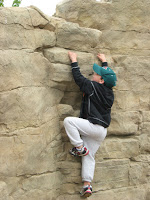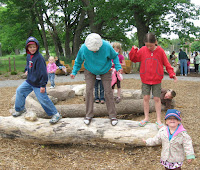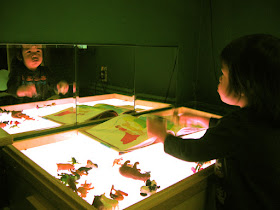 |
| Skyline at Chicago Children's Museum (Eileen Ruan Photograhy ©2011) |
A great new tool set is now available and on-line to help power dreams of starting museums for children. It’s the Association of Children’s Museum’s Collective Vision Toolkit for Starting and Sustaining a Children’s Museum.
I can only imagine how starting Madison Children’s Museum might have progressed 30+ years ago had we had had the Collective Vision Toolkit. I’m pretty sure it would have been easier and faster and we would have gotten some things right sooner. That’s probably true as well for other efforts to start hundreds of children’s museums across the country and around the world over the last 30 years.
The Collective Vision Toolkit is a priceless on-line resource of collective wisdom from people who have started museums, lead new museums, and grown museums to become recognized and valued community resources. While I’ve helped start a children’s museum, work as a museum planner with emerging children’s museums, and worked on this Toolkit, I’m still finding new and useful resources and learning new things inside the toolkit.
The idea for an on-line resource that could provide the basics for every start-up came from an anonymous donor and a true friend of children’s museums. In 2008 the Association of Children’s Museums (ACM) began thinking about possible content and format. The next year, it handed off development to Mary Maher, Editor of Hand To Hand and Collective Vision, John Noonan, Executive Director at GreatLake Children’s Museum , and me.
The Toolkit is an ACM members only resource currently available on a demo site for ACM’s new website and available through the summer. Check it out at: www.childrensmuseums.org
Getting to Know the Toolkit
The Toolkit is accessible, conveniently organized, and multi-layered. Toolkit topics are just what you would expect and, perhaps, more important, would hope for in navigating new territory with a group of friends or a fledgling board to plan a museum for children. Topics range from the nitty gritty of getting tax-exempt status to a more philosophical meander through learning in museums. Topic titles such as Site Selection and Marketing are straight-forward. When a topic like Founding Governance does require some unpacking, it’s expanded: Gathering the people and building the structure to govern your museum.
Twelve topics move in a general sequence from the earliest glimmer of, “Let’s start a children’s museum” to opening the doors and considering what comes next. Steps are a clear, intuitive organizing principle. As a step-based approach the Toolkit is still both process oriented and flexible. Reinforcing this, Mary encourages both a beginning-to-end pathway and a pick-and-choose approach in her Toolkit introduction. The Case Studies in the final section, Opening the Doors, demonstrate this in being valuable for a museum at any stage of the process.
Each topic has three sections: an overview, common questions, and resources. The overview starts with highlights of what a museum has typically accomplished when it is at this step. It’s followed by a checklist for moving forward and by some of the sub-steps and issues likely at this point. This is a great set-up for the resources that follow: templates of standard documents, sample letters and policies, links to more online resources and organizations, and a bibliography. The FAQ’s handle perennial questions and address complicated or sensitive situations that arise over the course of any journey.
While valuable for starting any museum, these materials are customized for children’s museums. This is helpful in the somewhat specialized areas of early learning and hands-on exhibits.
Collective Wisdom
Something may seem amiss in calling this blog entry: Collective Wisdom for Starting and Growing Museums. After all, Collective Vision is the well-known title of ACM’s 1997 publication. Its collected advice from those who have created children’s museums addresses a full range of considerations for others on a similar path. In 14 years it has become a touchstone among museum leaders, more than a few of who have used it as a resource to start or expand a museum.
This same collective wisdom and more is present in the Toolkit. Questions posted on ChildMus and years’ of helpful responses are covered. Should we hire professional fundraisers? Or, someone has offered us a great space for free in a mall/other location; should we take it? A synthesis of current thinking and practice provides background on and orientation to topics like fundraising, budgets, and staff and volunteers.
As an on-line resource, however, the Toolkit is even more a product of collective wisdom. Links to BoardSource, Guidestar, the Kellogg Foundation Communication Toolkitand dozens more organizations connect to their focused wisdom.
Within a rich range of resources are what I consider working tools: ready-to-use templates, like “Board Phone Log for Donor Thank You Outreach” and “Museum Trustee Evaluation” (with a place for a museum’s logo). They have been road tested by John Noonan who most generously has shared sample documents, templates, and forms. His collection has justifiably been called a goldmine. At past Emerging Museums Pre-conferences John provided templates on a CD. These CD’s were such great resources that afterwards he continued to not only get requests for them, but also received e-mails thanking him for them.
Starting Museums
Besides providing valuable content for starting a museum, the Toolkit is a helpful guide about the nature of the start-up process itself. Although steps in starting a museum are sequential, they are not automatic. The case studies illustrate this with variations in the sequence of a fairly standard process. Site selection, for instance, may happen earlier in the process as an opportunity or later when many pieces are in place and having a location is needed for fundraising to really kick in.
“At this point there is…” followed by a list of key accomplishments relevant to each step actively reaches out to folks navigating this new territory. I was delighted when John introduced this format. It orients and provides a simple diagnostic of whether this is the right step and whether the museum is ready. Is there a board ready to carry the mission to the next level? Are the articles of incorporation filed with the state? Is there a letter confirming your existence? If these and a few other conditions are met, it’s the right time to take the step. On the other hand, if many or most of these conditions aren’t completed, the museum isn’t ready. A close look at those conditions helps determine where to place effort.
“At this point” and “key accomplishments” often refer to other steps in the Toolkit and reflect the inherent interconnectedness of decisions. The checklist for “Moving Forward” extends a helping hand by addressing important accomplishments to focus on at each step. In Staff and Volunteers, a museum is advised to use the strategic business plan and museum master plan to determine the key positions to fill and in what order. Equally important, suggested actions point to the value of thinking of ahead: “Lay the foundation for a positive organizational culture and climate.”
The Collective Vision Toolkit has a strong and natural connection to ACM’s Emerging Museums Pre-conference at InterActivity. Both are ACM services to start-up member museums. Some Toolkit material was prepared for and presented by John, me, and others at past pre-conferences. The Toolkit also has significant potential value as structure and content for the Emerging Museums Pre-conference. In turn, the Pre-conference can become a vehicle for developing and gathering more and current resources, and updating the Toolkit annually.
Growing Museums
The Toolkit is not just for emerging museums. Even experienced executive directors leading museums of every size need to re-ground in areas over the years. Filing for non-profit status happens just once in an organization’s life. But board development and reviewing the mission statement is needed every year-or-so. Revisiting exhibit planning can be valuable before any large project. The Toolkit helps in getting oriented, finding resources, and preparing for work.
Links to other ACM resources also broaden the Toolkit’s usefulness to more kinds of museums and museums at different stages of development. Building and Exhibits links to the ACM Product and Resources List, to Green Exhibits, and to Healthy Kids, Healthy Museums publication. Staff and Volunteers links to ACM’s HR Support Toolkit.
Established museums share similarities with start-up museums at different times. In preparing to grow or change in a significant way, a museum needs many of the same resources that a start-up museum needs. As a museum explores relocating, expanding at its current site, launching a capital campaign, or rethinking its exhibits, it faces many of the same questions, processes, and challenges as a museum starting up. When a major project is complete, that museum is inexperienced in its new context very much like a new museum. Having worked with museums that are expanding and reinventing themselves, I know the Toolkit has relevant resources for guiding and strengthening them as they navigate change.
The Toolkit is full of spot-on advice for museums preparing for change, increasing capacity, or trying to meet annual goals. One piece of advice tops my list: “Though different people have different roles, fundraising is everyone's responsibility.”
Toolkit With a Future
The Toolkit was designed with a flexible format. Individual sections and forms can be updated and added. Updating is not only standard in an on-line world, but also reflects the reality in which museums start and grow. Museums interact with a dynamic environment; practices evolve; established museums take risks and learn; and new tools like ACM’s Benchmarking Calculator are developed. These and other changes can and should be integrated with the Toolkit. New case studies should highlight emerging trends.
When Minnesota Children’s Museum built its new building in 1993-1995, I read and re-read (and re-read) a 1986 draft of a case study of Boston Children’s Museum moving to Museum Wharf in 1976 - 1979 by Elaine Gurian. I think the Toolkit is that kind of resource for others. And more. As an on-line tool, it’s fast, current, updatable, with direct links to vast resources. Those qualities and the possibility of children’s museums for more communities will make The Toolkit the must-have, often-used, and ever-referenced resource.
The more the Toolkit is used and added to, the stronger, more useful it becomes. I encourage you to visit the Toolkit. Think about and share with me, ACM, and others, your thoughts, ideas, and suggestions.
Add to the collective wisdom.
• Are resources you have found helpful included in the Toolkit?
• What resources would you like to see added?
• Do you know of any resources that are specific to children’s museums to add?
• Are there sections that can it be stronger?
• Are there more ways the Toolkit can relate to the other tools, such as Collective Vision?























